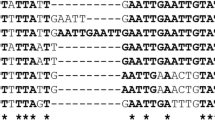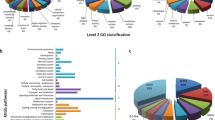Abstract
Molecular markers play an important role in identifying the species variation, characterizing the genic diversity, and also linking the identified markers to trait of interest. Genome- and transcriptome-derived molecular markers have been widely used to understand the geographical diversity and have also played a major role in the development of high-density linkage maps. In the present protocol, we present a detailed protocol on bioinformatics approaches towards the whole-genome and transcriptome-assisted simple sequence repeats (SSRs) marker mining in Brachypodium distachyon and identification of orthologus SSRs and their validation in Brachypodium ecotypes. We also present a protocol for the validation of the identified markers.
Similar content being viewed by others
References
Ellegren H (2014) Microsatellites: simple sequences with complex evolution. Nat Rev Genet 5:435–445
Leclercq S, Rivals E, Jarne P (2010) DNA slippage occurs at microsatellite loci without minimal threshold length in humans: a comparative genomic approach. Genome Biol Evol 2:325–335
Morgante M, Hanafey M, Powell W (2002) Microsatellites are preferentially associated with nonrepetitive DNA in plant genomes. Nat Genet 30:194–200
Weitzman JB (2002) Microsatellites in plant genomes. Genome Biol 3:spotlight-20020128-01
Sonah H, Deshmukh RK, Sharma A, Singh VP, Gupta DK, Gacche RN et al (2011) Genome-wide distribution and organization of microsatellites in plants: an insight into marker development in Brachypodium. PLoS One 6(6):e21298
Xiao Y, Xia W, Ma J, Mason AS, Fan H, Shi P, Lei X, Ma Z, Peng M (2016) Genome-wide identification and transferability of microsatellite markers between Palmae species. Front Plant Sci 7:1578
Suresh BM, Nagarajaram HA (2007) IMEx: imperfect microsatellite extractor. Bioinformatics 23:1181–1187
Xia E-H, Yao Q-Y, Zhang H-B, Jiang J-J, Zhang L-P, Gao L-Z (2016) CandiSSR: an efficient pipeline used for identifying candidate polymorphic SSRs based on multiple assembled sequences. Front Plant Sci 6:1171
Author information
Authors and Affiliations
Corresponding author
Editor information
Editors and Affiliations
Rights and permissions
Copyright information
© 2018 Springer Science+Business Media LLC
About this protocol
Cite this protocol
Sablok, G., Mudunuri, S.B., Gudys, K., Chennamsetti, K., Varma, G.P.S., Kwasniewski, M. (2018). Evaluation of Genome-Wide Markers and Orthologous Markers in Brachypodium distachyon . In: Sablok, G., Budak, H., Ralph, P. (eds) Brachypodium Genomics. Methods in Molecular Biology, vol 1667. Humana Press, New York, NY. https://doi.org/10.1007/978-1-4939-7278-4_15
Download citation
DOI: https://doi.org/10.1007/978-1-4939-7278-4_15
Published:
Publisher Name: Humana Press, New York, NY
Print ISBN: 978-1-4939-7276-0
Online ISBN: 978-1-4939-7278-4
eBook Packages: Springer Protocols




